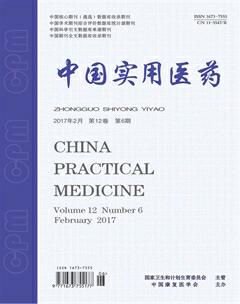单孔法腹腔镜手术治疗儿童腹股沟斜疝的应用价值研究
周正强

【摘要】 目的 探究单孔法腹腔镜手术对儿童腹股沟斜疝的治疗效果。方法 60例腹股沟斜疝儿童, 按照随机数字表法分为A、B两组, 各30例。其中A组进行腹股沟疝囊高位结扎术, B组使用单孔法腹腔镜手术进行治疗。对比两组患者治疗效果、手术一般情况以及不良反应发生情况。结果 两组治疗总有效率均为100%, 对比差异无统计学意义(P>0.05)。B组手术时间为(21.48±5.47)min、术中出血量为(1.84±0.24)ml, 住院时间为(1.89±0.62)d, 均优于A组的(41.24±8.54)min、(2.25±0.21)ml、(2.26±
0.63)d, 差异具有统计学意义(P<0.05)。所有患者中均无不良反应。结论 对腹股沟斜疝患儿使用单孔法腹腔镜手术进行治疗患者手术时间更短, 术中出血量更小且有利于患儿恢复, 安全性较高, 可进行临床推广。
【关键词】 单孔法腹腔镜手术;儿童腹股沟斜疝;应用价值
【Abstract】 Objective To investigate curative effect by single-port laparoscopic surgery for children oblique inguinal hernia. Methods A total of 60 children with oblique inguinal hernia were divided by random number table into groups A and B, with 30 cases in each group. Group A received inguinal hernia sac hight ligation, and group B received single-port laparoscopic surgery for treatment. Comparison was made on curative effect, general operation condition and adverse reactions between the two groups. Results Both groups had total effective rate as 100%, and their difference had no statistical significance (P>0.05). Group B had operation time as (21.48±5.47) min, intraoperative bleeding volume as (1.84±0.24) ml, and hospital stay time as (1.89±0.62) d, which were all better than (41.24±8.54) min, (2.25±0.21) ml and (2.26±0.63) d in group A, and their difference had statistical significance (P<0.05). There was no adverse reaction in any patient. Conclusion Implement of single-port laparoscopic surgery for children oblique inguinal hernia patients shows shorter operation time and less intraoperative bleeding volume. This method is beneficial for children rehabilitation with high safety, and it is worth clinical promotion.
【Key words】 Single-port laparoscopic surgery; Children oblique inguinal hernia; Application value
儿童腹股沟斜疝是由于胎儿时期发育缺陷导致鞘状突未完全闭合导致, 近年来由于腹腔镜技术以及微创技术的不断发展, 单孔法腹腔镜手术被应用于腹股沟斜疝中, 有研究表明, 在腹腔镜下行小儿腹股沟斜疝手术成功率可以达到98%, 气腹状态下内环口较易尋找, 且清洗分辨精索以及输精管后可以避免术中损伤, 对排除侧隐匿疝也具有一定效果[1]。本文对2015年4月~2016年10月入诊本院进行治疗的60例腹股沟斜疝儿童进行不同手术方式的对比研究, 取得一定研究成果, 现报告如下。
1 资料与方法
1. 1 一般资料 选取2015年4月~2016年10月本院进行治疗的60例腹股沟斜疝儿童, 按照随机数字表法将所有患儿分为A、B两组, 各30例。所有患儿均符合腹股沟斜疝的诊断标准[2]。本研究已经取得所有患者以及家属的知情同意并通过伦理委员会。A组中男28例, 女2例, 年龄2~13岁, 平均年龄(7.12±2.88)岁, 单侧疝24例, 双侧疝6例。B组中男27例, 女3例, 年龄2~14岁, 平均年龄(7.53±2.70)岁, 单侧疝25例, 双侧疝5例。两组患儿一般资料比较差异无统计学意义(P>0.05), 具有可比性
1. 2 方法 A组进行腹股沟疝囊高位结扎术, 所有患儿均行气管插管全身麻醉, 取下腹横纹切口, 长约2 cm, 切开皮肤、皮下, 于外环口寻找疝囊, 打开疝囊前壁, 提起后壁, 游离疝囊后壁, 注意保护好精索、输精管无损伤, 高位缝扎疝囊颈两道, 剪除疝囊残端, 睾丸位于阴囊底, 检查局部无出血逐层缝合, 结束手术。B组患者进行单孔法腹腔镜手术, 前期准备:对患儿进行气管内麻醉, 经脐下缘进行切口, 切口约为1.0 cm, 将气压调节至8~10 mm Hg(1 mm Hg=0.133 kPa), 建立气腹, 将30°腹腔镜放入, 同一切口置入5 mm操作钳, 患儿体位保持头低足高位30°, 对膀胱三个褶皱以及左右内环口处进行观察, 对患侧内环口进行检查, 同时注意对侧隐性疝进行排除。手术过程:2-0不吸收缝线在内环口环形缝合1周, 避免损伤精索血管及输精管。对缝扎效果进行检查, 若效果满意则将trocar退出。

